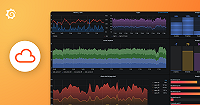Deploy Pyroscope with Jsonnet and Tanka
Grafana Labs publishes a Jsonnet library that you can use to deploy Pyroscope. The Jsonnet files are located in the Pyroscope repository and are using the helm charts as a source.
Install tools and deploy the first cluster
You can use Tanka and jsonnet-bundler to generate Kubernetes YAML manifests from the jsonnet files.
Install
tankaandjb:Follow the steps at https://tanka.dev/install. If you have
goinstalled locally you can also use:# make sure to be outside of GOPATH or a go.mod project go install github.com/grafana/tanka/cmd/tk@latest go install github.com/jsonnet-bundler/jsonnet-bundler/cmd/jb@latestSet up a Jsonnet project, based on the example that follows:
- Initialize Tanka
- Install Pyroscope and Kubernetes Jsonnet libraries
- Set up an environment
# Initialize a Tanka directory mkdir jsonnet-example && cd jsonnet-example tk init --k8s=1.21 # Install Pyroscope jsonnet jb install github.com/grafana/pyroscope/operations/pyroscope@main # Install required tanka-util jb install github.com/grafana/jsonnet-libs/tanka-util@master # Setup your current cluster as the server for the default environment tk env set environments/default --server-from-context=$(kubectl config current-context)Decide if you want to run Pyroscope in the monolithic or the microservices mode
Option A) For monolithic mode the file
environments/default/main.jsonnet, should look like;local pyroscope = import 'pyroscope/jsonnet/pyroscope/pyroscope.libsonnet'; local tk = import 'tk'; pyroscope.new(overrides={ namespace: tk.env.spec.namespace, })Option B) For microservices mode the file
environments/default/main.jsonnet, should look like;local pyroscope = import 'pyroscope/jsonnet/pyroscope/pyroscope.libsonnet'; local valuesMicroServices = import 'pyroscope/jsonnet/values-micro-services.json'; local tk = import 'tk'; pyroscope.new(overrides={ namespace: tk.env.spec.namespace, values+: valuesMicroServices, })
Generate the Kubernetes YAML manifests and store them in the
./manifestsdirectory:# Take a look at the generated YAML manifests. tk show environments/default # Export the YAML manifests to the folder `./manifests`: tk export ./manifests environments/defaultDeploy the manifests to a Kubernetes cluster, in one of two ways:
Use the
tk applycommand.Tanka supports commands to show the
diffandapplychanges to a Kubernetes cluster:# Show the difference between your Jsonnet definition and your Kubernetes cluster: tk diff environments/default # Apply changes to your Kubernetes cluster: tk apply environments/defaultUse the
kubectl applycommand.You generated the Kubernetes manifests and stored them in the
./manifestsdirectory in the previous step.You can run the following command to directly apply these manifests to your Kubernetes cluster:
# Review the changes that will apply to your Kubernetes cluster: kubectl apply --dry-run=client -k manifests/ # Apply the changes to your Kubernetes cluster: kubectl apply -k manifests/
Note: The generated Kubernetes manifests create resources in the
defaultnamespace. To use a different namespace, change thenamespaceconfiguration option in theenvironments/default/main.jsonnetfile, and re-generate the Kubernetes manifests.


